SUMMARY
- Newly obtained FOIA documents from America First Legal reveal Department of Homeland Security (DHS) plans to produce training videos that get “bystanders” to intervene against “radicalization” of their peers.
- DHS targeted “suburban Moms” with pro-life beliefs and “old high school friends” who believe in “conspiracies” as examples of radicalized citizens in need of bystander intervention.
- These findings add to the litany of evidence that DHS has shifted its focus from threats of foreign terrorism to monitoring and meddling in domestic US citizen political beliefs.
Apparently not content with setting up a Ministry of Truth, an Internet censorship directorate, and even a program for controlling speech in video games, the Department of Homeland Security (DHS) has devised yet another dystopian program for domestic thought control: pushing citizens to monitor each others’ political beliefs under the guise of “deradicalization.”
So reveal new documents obtained by America First Legal (AFL) under the Freedom of Information Act (FOIA).
The FOIA files show DHS’s Office of Terrorism and Violence Prevention (“OTVTP,” now known as “CP3”) using taxpayer dollars in January 2021 to screenwrite an online “Choose Your Own Adventure”-style video series to “deradicalize” friends and family.
DHS’s “radicalization suspects” in the video screenplays are not violent terrorists or extremists. They are typical everyday Americans with typical everyday American opinions.
For example, DHS constructs a detailed profile for “Ann,” a “middle-aged pro-life advocate” — she is a “suburban Mom” surrounded by stock footage of “laundry” and “Minivan” who “has become increasingly more concerned about the welfare of other children:”
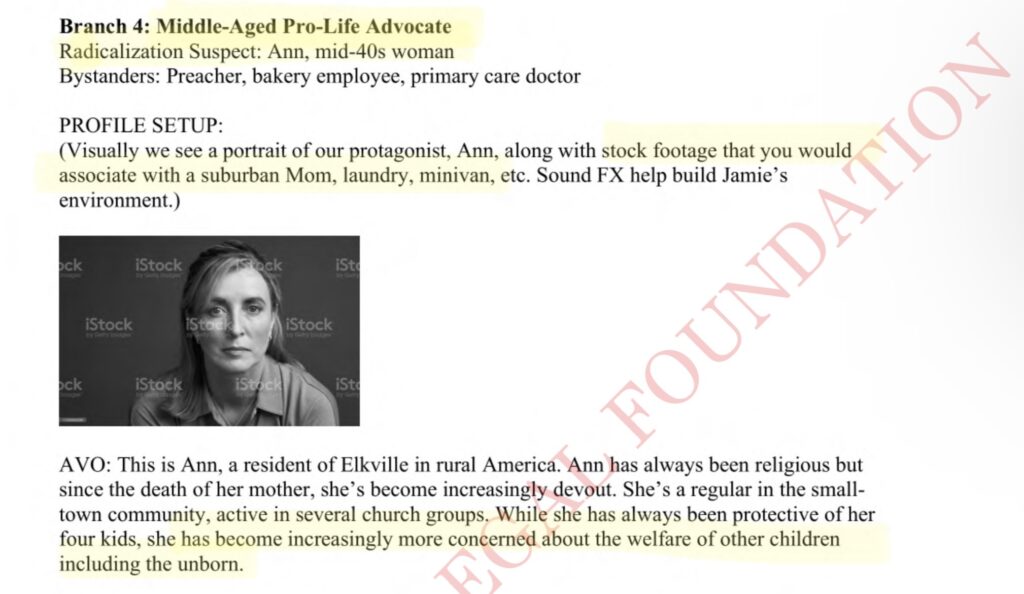
Ann is an example of an ordinary American who happens to have a pro-life opinion. But according to DHS, an agency first created to stop another 9/11, this opinion warrants a government-funded video training instructing her entire community to treat her as a radical, and to take real-life action against her First Amendment-protected statements.
Audiences of DHS’s deradicalization videos would take the role of “bystanders” that are given options on how to intervene in Ann’s political development. For example, audiences watch Ann’s activities from the perspective of her preacher, her longtime friend, and her hairdresser.
In one scenario, Ann utters the phrase “baby killer” at a public ribbon-cutting event at a local bakery. DHS gives you, the bystander, three choices: calling Ann’s husband, contacting Ann’s preacher, or stopping by Ann’s house:
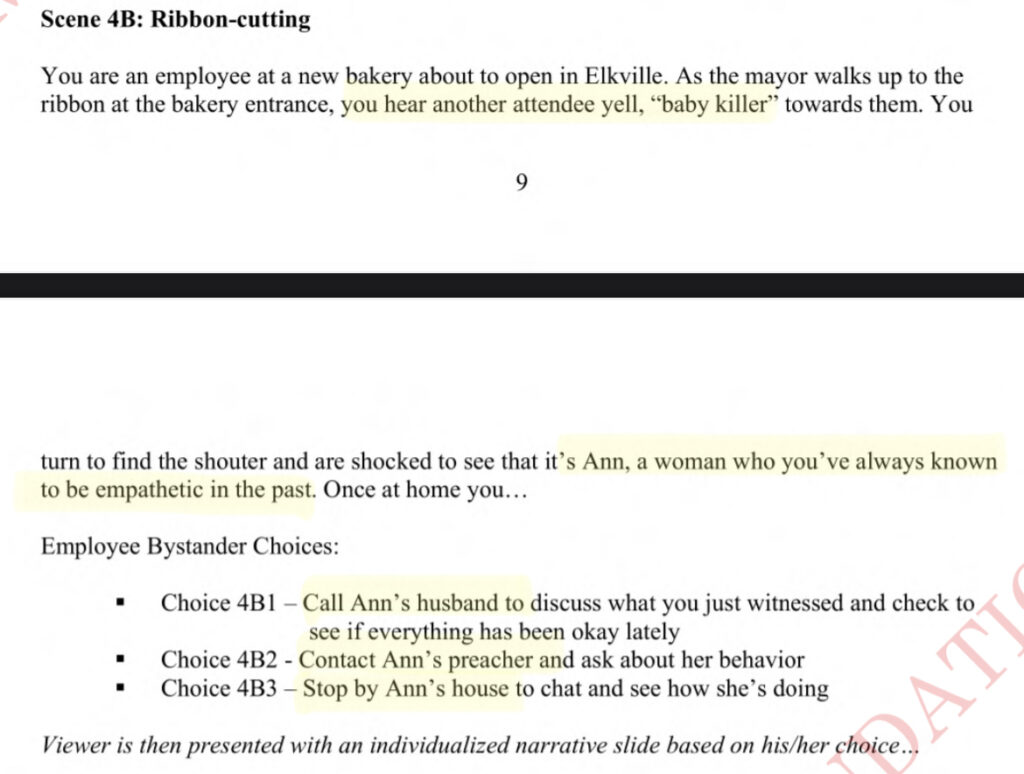
In another scenario, as Ann’s hairdresser, viewers listen to Ann “bring up pro-life arguments and… ranting,” after which Ann shows “videos of violent protests on her phone.”
Bystanders are given three choices: calling the sheriff on Ann, talking about Ann to coworkers, or researching the groups Ann talked about:
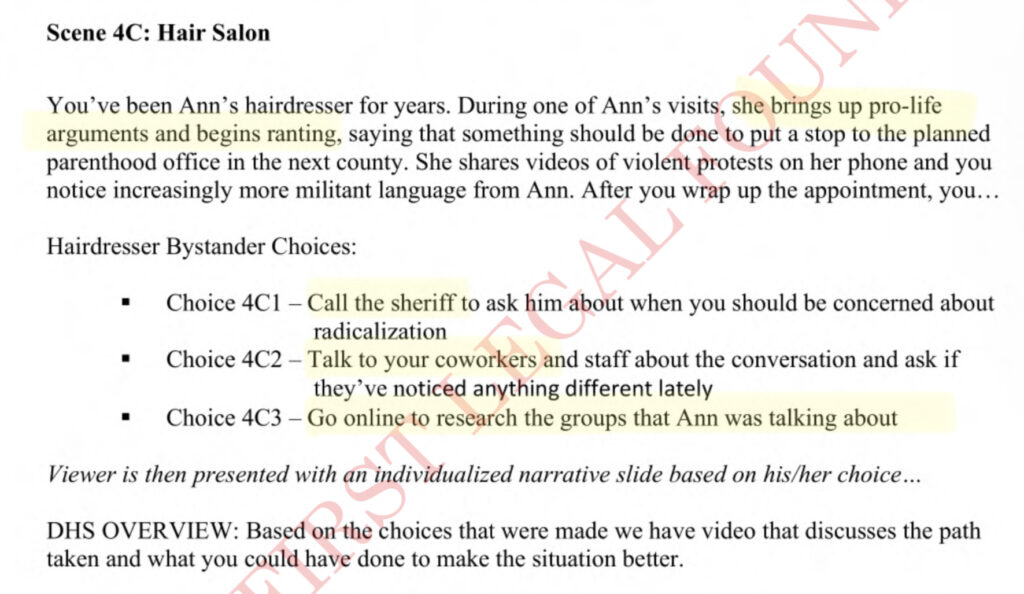
Note above that DHS also directs viewers to reflect on what more they could have done to “make the situation better.”
This is essentially a state-funded instruction video for creating a modern Stasi class where citizens are encouraged to report on one another – even when no laws have been broken.
DHS also built a stock profile for “Courtney,” an “old high school friend” of audience members who has become a “budding conspiracy theorist.” She, too, is associated by DHS with the imagery of “suburban Mom, laundry, minivan.” What gets her wrapped up in DHS’s informant dragnet is that after her divorce, she “has become fixated on conspiracy theories regarding government connections to child abuse and trafficking:”
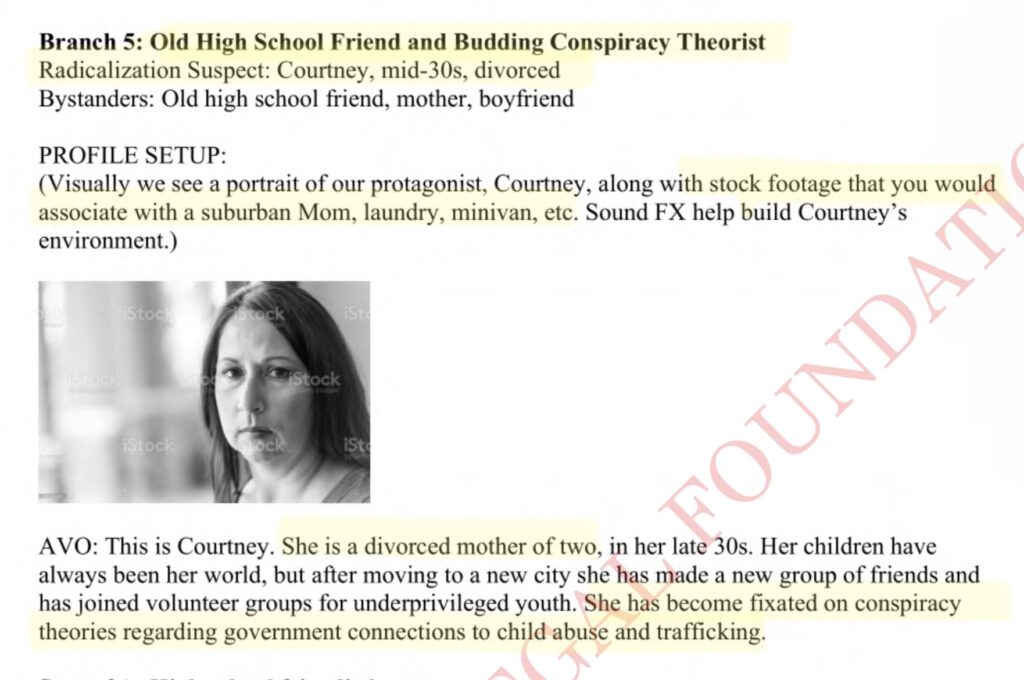
In the case of Courtney, “spreading conspiracy theories” and even the perceived “level of anger” rising in her online posts is sufficient to trigger DHS involvement. DHS gives three choices to bystanders: monitor Courtney’s other posts and conversations, check in with her ex-husband, or message her to snoop on her private life:
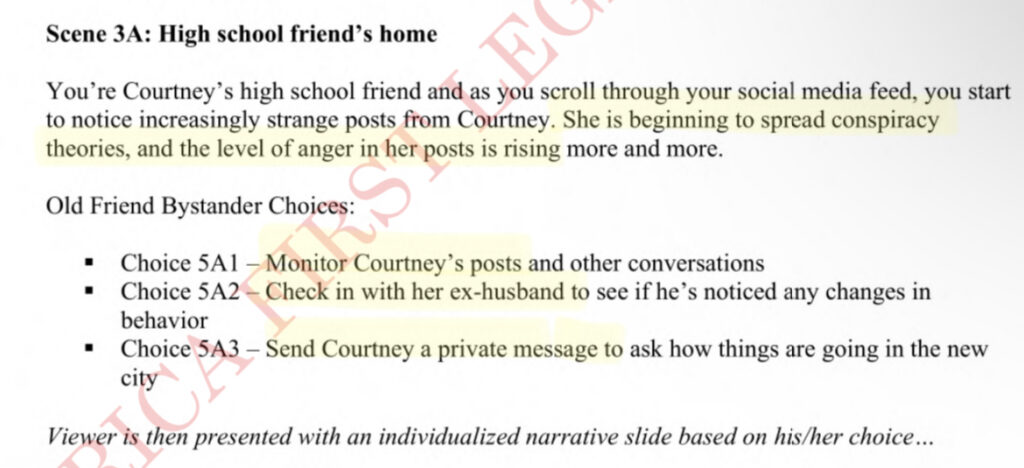
DHS also built a stock profile for “Pete,” an “anti-government, anti-authority” father as an example of “radicalization suspects” that should be dealt with by citizen bystanders.
We are told Pete is an “abusive parent/stepdad” but no details are given as to what makes him abusive. He “seems like a quiet guy and mostly keeps to himself:”

Pete’s political activity that triggers DHS intervention is that a bystander has “seen him post on some radical sites with violent tendencies.” DHS does not say Pete himself made any calls to violence, and it is unclear how a static website itself can have “violent tendencies.”
Nonetheless, DHS walks bystanders through three options: contacting Pete’s wife, interrogating Pete about it at a softball game, or simply keeping “closer tabs” on Pete’s online activity:
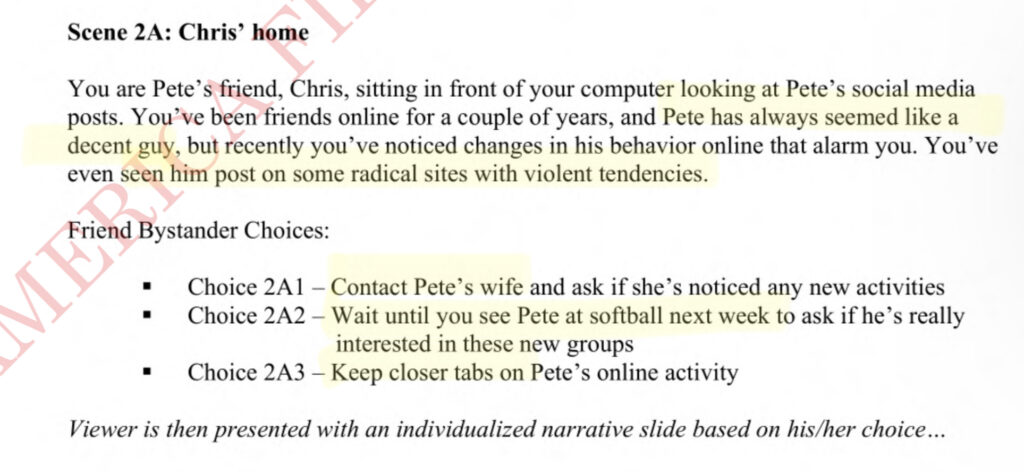
Under the Biden Administration, DHS appears to be moving into the video propaganda space for policing political opinions in a new and disturbing way. For example, FFO previously reported how DHS created a cartoon that urged young people to report their own family members to Facebook for “disinformation” for social media posts that claimed “Covid is no worse than the flu.”
DHS produced an entire line of similar “disinformation”-policing video products.
As with DHS’s Covid speech policing, DHS’s “deradicalization” speech policing does not seek target illegal speech or criminal behavior, but rather seeks to intervene in speech that expresses skepticism of the US government or conveys support for domestic political causes that the Biden Administration is politically targeting.
In other words, what DHS is doing is the epitome of weaponization of the federal government.
It is telling that such “political police” programs are now parked at DHS, rather than at the FBI. The FBI is limited in its role to being the intelligence arm of the Justice Department, which requires suspicion of lawbreaking to deploy government resources. While the FBI has expanded its “political police” powers with recent guidance targeting US citizens who use generic Internet slang, DHS appears to think it can operate on the edges of political activity in the “lawful speech” zone that the FBI is barred from targeting directly.
What DHS is getting away with is also a striking attack on the protections from government interference afforded to Americans under the Supreme Court decision Brandenburg v. Ohio (1969). Brandenburg held that the US government cannot intrude on US citizen speech unless the speech is likely to incite “imminent lawless action.”
None of the speech episodes in DHS’s deradicalization scenarios are illegal. The speech being targeted is all “long fuse” speech – to cite the phrase used by DHS’s formal election censorship partners, the Election Integrity Partnership. That is, rather than incitement, the targeted speech is pure internal expression. Rather than imminent, the speech is a “long fuse” away from action. Rather than involving lawlessness, it is lawful. And rather than involving action, the speech is pure opinion.
Teaching everyday American citizens to police the opinions and behavior of their peers via these online training products represents just one segment of a synchronized “whole-of-society” censorship effort composed of private firms, universities, and the government that has been spearheaded by DHS to target emerging narratives being popularized among the public. FFO has extensively covered how this public-private DHS-deputized censorship industry turned inwards to censor online speech of Americans first during the run-up to the 2020 election cycle. That timeline makes it all the more concerning that the proposed products examined in these FOIA’d AFL files are dated Jan. 29, 2021, just one week after the Biden Administration took office.
While this DHS video series primes American citizens to monitor one another’s online speech, the Biden Administration’s National Security Strategy for Countering Domestic Terrorism specifically touted “the Department of Homeland Security and others are either currently funding and implementing or planning evidence-based digital programming, including, enhancing media literacy and critical thinking skills, as a mechanism for strengthening user resilience to disinformation and misinformation online for domestic audiences.” (page 20). Further, it stated that the Biden Administration “will pursue innovative ways to foster and cultivate digital literacy and related programs, including educational materials and interactive online resources such as skills-enhancing online games.” (page 22).
“Digital literacy,” as FFO has previously reported, is just censorspeak for giving the censorship industry control over citizens’ digital news sources and social media newsfeeds.
The House of Representatives set up a weaponization subcommittee for oversight and accountability to take on precisely these kind of government abuses. The House Homeland Security Committee, which has a hearing this Thursday on DHS abuses, is also well positioned to hold DHS to account.
Will Congressional investigators succeed in reigning in DHS’s new political police? Or will the department’s entrenched bureaucracy, with its thick web of censorspeak, succeed in evading sunlight? One thing is certain: the tone set by elected representatives this week will set the stage for whether the censorship industry feels confident in using a government agency as a perch for thought control in the future, or whether they will get the message that such abuses will never be tolerated again.

Michael Benz is the Executive Director of the Foundation for Freedom Online. Previously, Mr. Benz served as Deputy Assistant Secretary for International Communications and Information Technology at the U.S. Department of State. Follow him on Twitter @FFO_Freedom.




